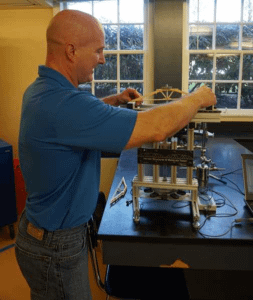Vernier is excited to announce the Go Direct® Structures & Materials Tester. It sports a new displacement sensor, a more rigid frame, and connects easily to our Graphical Analysis™ 4 app. While bridge building competitions are not the only activities that you can conduct with the Structures & Materials Tester, they may be the most fun. There is a carnival-like atmosphere when students put their engineering design and construction skills to the test and see how they fare against their peers.
Some teachers excel at making this event not only fun, but very educational. Riverdale High School’s Mark Wechter is one of those teachers. His students have competed in the Illinois Institute of Technology International Bridge Competition for years and, since integrating Vernier technology into the classroom, his students have won the contest two out of the last three years. We sat down with him to find out how he built such a successful program and how technology has helped him in the effort.
Q: Tell us a little bit about your background. When did you start teaching?
A: This is my 24th year of teaching. I started at the high school in Brookings, Oregon, and started a bridge-building program there. Brookings is where I grew up and where my father taught; I first did bridge building in his class. I always thought that was a valuable way of learning, so I started a bridge-building program here at Riverdale High School, in Portland, Oregon, in 1999.
Q: How has data-collection technology affected the bridge-building activities?
A: We used to use a lever-and-bucket system to test bridges; the process would destroy the bridge. Now, students can test their bridges several times using the Vernier Structures & Materials Tester. Each time they test the bridge, only one little spot breaks; they’re not continuing to have that downward gravitational force that’s going to destroy the whole thing. Students can over-build that one spot and test it again without having to rebuild the entire bridge.

Q: How do you introduce bridge building to your students?
A: We start with the force distributed in a truss, but without numbers and very simple designs. Then, I provide students with a hypothetical load position and have them determine which members are in compression and which are in tension. Then, we start applying the math.
Q: What advice can you give to other bridge-building coaches or physics teachers?
A: There is a balance between giving students some basic instruction without designing their bridge for them. I will tell my students if their design is outside the rules or there is a fatal flaw, but then it’s up to them to figure out how to fix it. The saying that my students both love and hate is, “It’s your bridge.” I spend a lot of time saying that. I like the level of anxiety that outside competition brings. It’s walking that fine line of wanting the student to care about this a lot, but not wanting them to feel like they don’t have any support.
